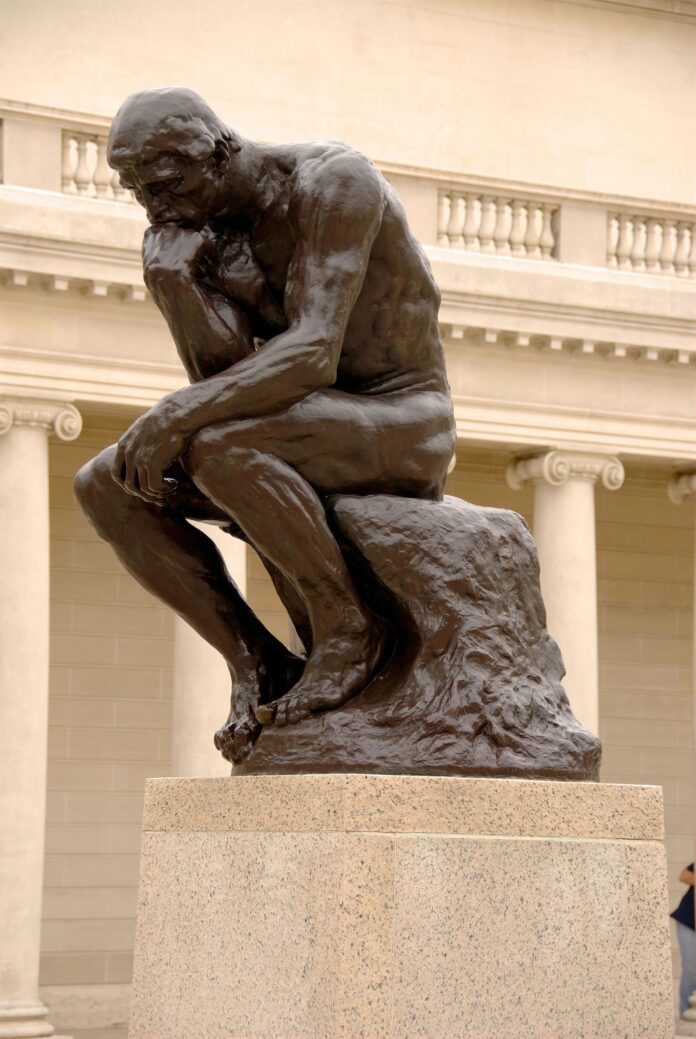Auguste Rodin, one of the most influential sculptors of the late 19th and early 20th centuries, left an indelible mark on the art world with his captivating creations. Among his renowned works, “The Thinker” stands as a timeless symbol of intellectual reflection and profound contemplation. In this article, we will delve into the historical context, description, interpretation, creation process, legacy, and criticism surrounding this iconic sculpture.
Historical Context:
“The Thinker” was conceived by Rodin during a period of profound societal change. The intellectual and philosophical movements were gaining traction. The late 19th century was characterized by an emphasis on individual thought and introspection, which deeply influenced Rodin’s artistic endeavors. His fascination with the human form and its ability to convey complex emotions laid the foundation for “The Thinker.”
Description and Interpretation:
“The Thinker” depicts a muscular nude figure seated on a rock. His brow furrowed in deep concentration, and his hand supported his chin. The sculpture’s powerful physique and contemplative pose evoke a sense of intellectual strength and introspection. Rodin masterfully captured the tension between the figure’s intense thought and the physicality of his form. Thus inviting viewers to ponder the nature of human existence and the pursuit of knowledge.
Interpretations of “The Thinker” vary a lot with different prominent people associating him with different things. Some perceive the figure as a representation of Dante Alighieri contemplating his magnum opus, “The Divine Comedy.” Others view the sculpture as a universal symbol of humanity’s eternal struggle with complex questions and the search for meaning. Regardless of interpretation, “The Thinker” embodies the human capacity for deep introspection and invites viewers to reflect on their own existence.
Creation Process:
The thinker required a very meticulous understanding and study of human anatomy. And Rodin put in the hours and efforts to acquire that deep knowledge of human anatomy. The processes he used for this ranged from simple observations, and sketches to life-like clay models he himself would create. For “The Thinker,” Rodin created multiple versions and variations, experimenting with different poses and anatomical details. Through this iterative process, he refined his vision and sought to capture the essence of profound contemplation.
Legacy and Impact:
When “The Thinker” was first exhibited in 1904, it garnered both admiration and controversy. The sculpture’s raw power and emotional depth challenged traditional artistic conventions of the time, and some criticized its unconventional style. However, its impact on subsequent generations of artists cannot be understated. “The Thinker” inspired numerous sculptors and became synonymous with the quest for knowledge and intellectual inquiry.
Today, “The Thinker” is prominently displayed in various locations worldwide, such as the Musée Rodin in Paris. And there is one at the entrance of the United Nations headquarters in New York City. Its universal appeal transcends cultural and linguistic barriers. Thus resonating with people from diverse backgrounds who seek to contemplate the human condition.
Criticism and Interpretation:
Over the years, “The Thinker” has been subject to different interpretations and critical analysis. Some argue that the sculpture predominantly reflects masculine introspection and neglects other perspectives, thereby limiting its universality. Others contend that the sculpture’s connection to Dante restricts its potential for a broader interpretation. However, these criticisms have not diminished the sculpture’s enduring impact and capacity to provoke contemplation. And it is still largely recognized as a testament to human intellectual curiosity.
Conclusion:
“The Thinker” by Auguste Rodin stands as an eternal symbol of intellectual curiosity, introspection, and the pursuit of knowledge. Its timeless appeal lies in its ability to transcend time and place, inviting viewers to delve into the depths of their own thoughts and emotions. Despite criticism and evolving interpretations, the sculpture’s significance remains intact, and its legacy continues to captivate and inspire generations of art enthusiasts and thinkers worldwide.
In the realm of art, “The Thinker” stands as a testament to the power of human expression and the enduring relevance of Rodin’s artistic genius. It serves as a reminder that introspection and contemplation are fundamental to our shared humanity, fostering a deeper understanding of ourselves and the world around us.
As always folks if you would like to read some interesting and informative articles in Hindi be sure to check out the Mojo Patrakar. Also if you liked this article check out some other interesting articles such as The Allure of Vintage Collectibles: Exploring the World of Retro Treasures.









